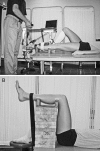Knee and ankle position, anterior drawer laxity, and stiffness of the ankle complex
- PMID: 18523573
- PMCID: PMC2386430
- DOI: 10.4085/1062-6050-43.3.242
Knee and ankle position, anterior drawer laxity, and stiffness of the ankle complex
Abstract
Context: Anterior drawer testing of the ankle is commonly used to diagnose lateral ligamentous instability. Our hypothesis was that changing knee and ankle positions would change the stability of the ankle complex during anterior drawer testing.
Objectives: To assess the effects of knee and ankle position on anterior drawer laxity and stiffness of the ankle complex.
Design: A repeated-measures design with knee and ankle position as independent variables.
Setting: University research laboratory.
Patients or other participants: Bilateral ankles of 10 female (age = 19.8 +/- 1.1 years) and 10 male (age = 20.8 +/- 1.2 years) collegiate athletes were tested.
Intervention(s): Each ankle complex underwent loading using an ankle arthrometer under 4 test conditions consisting of 2 knee positions (90 degrees and 0 degrees of flexion) and 2 ankle positions (0 degrees and 10 degrees of plantar flexion [PF]).
Main outcome measure(s): Recorded anterior laxity (mm) and stiffness (N/mm).
Results: Anterior laxity of the ankle complex was maximal with the knee positioned at 90 degrees of flexion and the ankle at 10 degrees of PF when compared with the knee positioned at 0 degrees of flexion and the ankle at 10 degrees or 0 degrees of PF (P < .001), whereas ankle complex stiffness was greatest with the knee positioned at 0 degrees of flexion and the ankle at 0 degrees of PF (P < .009).
Conclusions: Anterior drawer testing of the ankle complex with the knee positioned at 90 degrees of flexion and the ankle at 10 degrees of PF produced the most laxity and the least stiffness. These findings indicate that anterior drawer testing with the knee at 90 degrees of flexion and the ankle at 10 degrees of PF may permit better isolation of the ankle capsuloligamentous structures.
Keywords: lateral ankle sprains; physical examination.
Figures




Similar articles
-
Examining Ankle-Joint Laxity Using 2 Knee Positions and With Simulated Muscle Guarding.J Athl Train. 2016 Feb;51(2):111-7. doi: 10.4085/1062-6050-51.3.06. Epub 2016 Feb 16. J Athl Train. 2016. PMID: 26881870 Free PMC article.
-
Joint stability characteristics of the ankle complex after lateral ligamentous injury, part I: a laboratory comparison using arthrometric measurement.J Athl Train. 2014 Mar-Apr;49(2):192-7. doi: 10.4085/1062-6050-49.2.07. Epub 2014 Feb 25. J Athl Train. 2014. PMID: 24568232 Free PMC article.
-
Simulated lateral ankle ligamentous injury. Change in ankle stability.Am J Sports Med. 1995 Nov-Dec;23(6):672-7. doi: 10.1177/036354659502300606. Am J Sports Med. 1995. PMID: 8600732
-
Biomechanical analysis of the ankle anterior drawer test for anterior talofibular ligament injuries.J Orthop Res. 1995 Jul;13(4):609-14. doi: 10.1002/jor.1100130417. J Orthop Res. 1995. PMID: 7674077
-
Quantitative evaluation method for clarifying ankle plantar flexion angles using anterior drawer and inversion stress tests: a cross-sectional study.J Foot Ankle Res. 2019 May 3;12:27. doi: 10.1186/s13047-019-0337-y. eCollection 2019. J Foot Ankle Res. 2019. PMID: 31073333 Free PMC article.
Cited by
-
Examining Ankle-Joint Laxity Using 2 Knee Positions and With Simulated Muscle Guarding.J Athl Train. 2016 Feb;51(2):111-7. doi: 10.4085/1062-6050-51.3.06. Epub 2016 Feb 16. J Athl Train. 2016. PMID: 26881870 Free PMC article.
-
Effect of Kinesio® Taping on Ankle Complex Motion and Stiffness and Jump Landing Time to Stabilization in Female Ballet Dancers.J Funct Morphol Kinesiol. 2019 Apr 8;4(2):19. doi: 10.3390/jfmk4020019. J Funct Morphol Kinesiol. 2019. PMID: 33467334 Free PMC article.
-
Joint stability characteristics of the ankle complex in female athletes with histories of lateral ankle sprain, part II: clinical experience using arthrometric measurement.J Athl Train. 2014 Mar-Apr;49(2):198-203. doi: 10.4085/1062-6050-49.2.08. Epub 2014 Feb 25. J Athl Train. 2014. PMID: 24568223 Free PMC article.
-
Diagnostic strategies for chronic lateral ankle instability: a narrative review.Ann Jt. 2024 Oct 29;9:41. doi: 10.21037/aoj-24-31. eCollection 2024. Ann Jt. 2024. PMID: 39540064 Free PMC article. Review.
-
Treatment algorithm for chronic lateral ankle instability.Muscles Ligaments Tendons J. 2015 Feb 5;4(4):455-60. eCollection 2014 Oct-Dec. Muscles Ligaments Tendons J. 2015. PMID: 25767783 Free PMC article.
References
-
- Freeman M.A. Treatment of ruptures of the lateral ligament of the ankle. J Bone Joint Surg Br. 1965;47(4):661–668. - PubMed
-
- Garrick J.G, Requa R.K. The epidemiology of foot and ankle injuries in sports. Clin Sports Med. 1988;17(1):29–36. - PubMed
-
- Brostrom L. Sprained ankles, I: anatomic lesions in recent sprains. Acta Chir Scand. 1964;128:483–495. - PubMed
-
- Lindstrand A. New aspects in the diagnosis of lateral ankle sprains. Orthop Clin North Am. 1976;7(1):247–249. - PubMed
-
- Hoppenfeld S. Physical Examination of the Spine and Extremities. New York, NY: Appleton-Century-Crofts; p. 1976.
Publication types
MeSH terms
LinkOut - more resources
Full Text Sources
Medical

